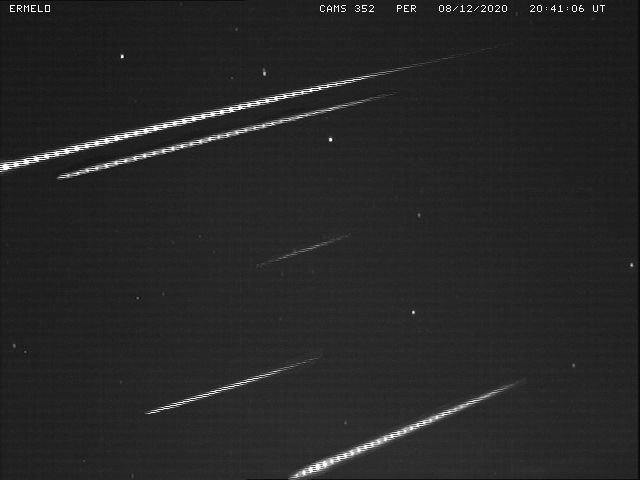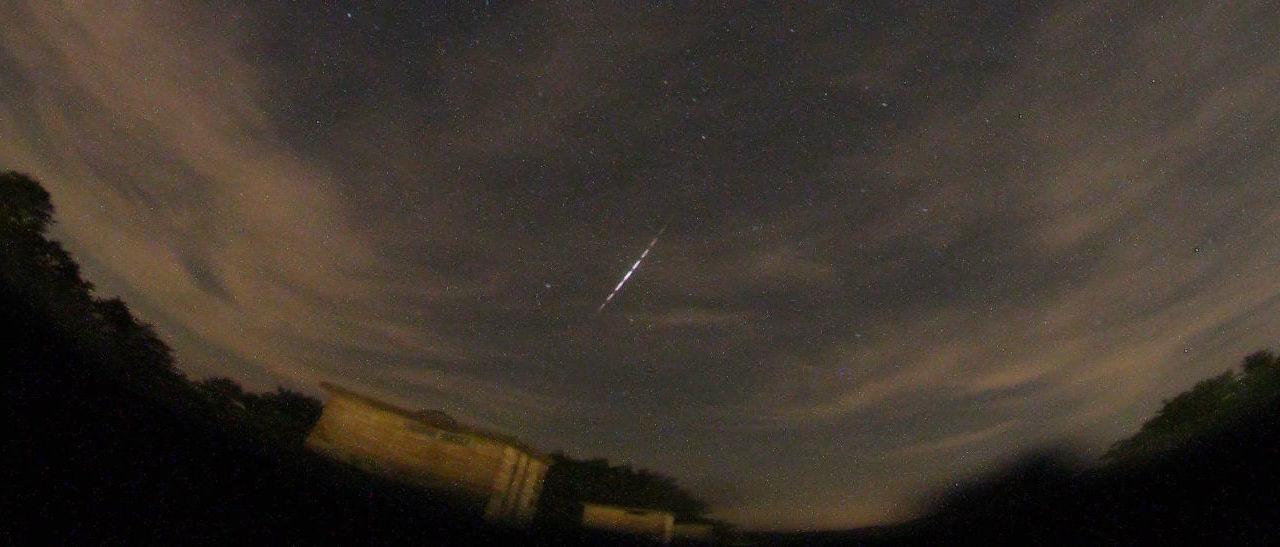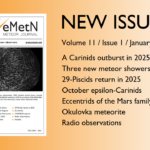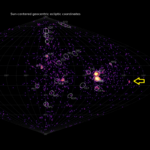 A report is presented about the visual meteor observations by the author during the 2020 Perseid activity.
A report is presented about the visual meteor observations by the author during the 2020 Perseid activity.
1 Introduction
In 2019, a number of participants decided to repeat the 2018 observing campaign in the Provence. For various reasons one week had been foreseen this year in Revest du Bion, the location where we stayed during the Perseids in 2014, 2015, 2016 and 2017. Unfortunately, due to the corona virus we had to cancel our journey to this location. The author had holidays from 18 July to 3 August. No plans were made for an alternative location, so any observations would have to take place from Ermelo in the Netherlands.
2 Comet C / 2020 F3 NEOWISE
In the run-up to the holiday, it turned out that Comet C/2020 F3 NEOWISE became much brighter than predicted. I was able to observe and photograph the comet on July 7, 12, 15 and 21. Visually, the comet was especially worthwhile on July 12, when I visually saw a tail of 3 degrees and estimated the comet at magnitude +1.5.

Figure 1 – Comet C / 2020 F3 NEOWISE photographed on July 12, 2020 around 01h47m UT. Camera: Sony Alpha A7s mark II. Lens: Canon 85mm F 1.8.
3 Meteor observations
Unfortunately, the weather hardly cooperated during the holiday period in the Netherlands. Only three nights allowed observations.
2020 July 20–21
The plan for this night was first to photograph Comet C/2020 F3 NEOWISE and then to observe meteors for a few hours. Unfortunately, it remained a failed attempt on the Groevenbeekse Heide to capture the comet due to equipment failure (the battery did not work properly due to leakage of one of the cells) and when that was finally resolved, it became cloudy.
Fortunately, after a while the clouds dissolved and I could start at 22h45m UT. The Groevenbeekse Heide is not completely flat, but there are walls created after the last Ice Age. Normally I lie in the lee of such a wall, but due to fog formation I decided to observe at the highest point. I was just above the fog layer. Unfortunately, it didn’t take long when clouds started to appear again and I ended the session early.
Between 22h45m and 23h27m UT I saw 9 meteors (lm 6.3) with 1 southern delta Aquariid (SDA), 1 Antihelion (ANT) meteor and my first Perseid (PER). No spectacular appearances, a +2 SDA was the most beautiful meteor.
Visual data: https://www.imo.net/members/imo_vmdb/view?session_id=80662
2020 July 21-22
This was the first successful meteor watch from the Groevenbeekse Heide. This session was ended a little earlier due to incoming clouds. Observations were done between 22h15m and 01h12m UT, 2.90 hours effective under highly transparent conditions with the lm rising to 6.4. Highest SQM value was 20.47.
The Perseids showed 3 meteors in the second and third hour. These were only faint meteors of +3 and +4. This also applied to the southern delta Aquariids (SDA), with only two of them in the last hour. The Capricornids did well. I counted 2, 1 and 1 per hour respectively. The last was a nice –2 Capricornid in Andromeda at 01h02m UT. This was also captured with the all sky camera. The sporadic meteors also showed beautiful things. At 22h56m UT a yellow magnitude –1 from Pegasus towards Delphinus. Another yellow magnitude -1 traversed Hercules at 0h14m UT. In total I saw 38 meteors, including 6 Perseids, 2 Southern delta Aquariids, 4 Capricornids, 3 Antihelions and 23 sporadic meteors. Attention was also paid to possible slow gamma Draconids (GDR) but nothing was seen from that region.
Visual data: https://www.imo.net/members/imo_vmdb/view?session_id=80663
2020 July 30-31
After more than a week with cloudy skies, it finally became clear on July 30th. In the meantime, the Moon had become quite a disturbing object again, it would only set around 23h45m UT and was already far towards full (80%). The lack of clear weather last week made me decide to start as soon as it was dark enough. In addition, it was always nice to see how the ambiance of the night changes as the Moon gets lower and lower. And the sky was clear so I expected to see enough. The period at the end of July is also known for the many bright meteors.
Period 21h45m–22h46m UT, effective 1.00 hours, Lm 5.7 increasing to 6.0.
Despite the moonlight 12 meteors (2 CAP, 2 PER, 8 SPO). The best was a +1 SPO in Cepheus at 21h58m UT. A Capricornid of +2 was also nice.
Period 21h46m–23h47m UT, effective 1.00 hours, Lm 6.0 increasing to 6.3.
The Moon was now very low in southwestern direction and would set during this period. In this period 16 meteors were seen (2 CAP, 2 ANT, 2 PER, 2 SDA and 8 SPO). The most beautiful meteors were at 23h01m UT (+1 sporadic in Andromeda) and 23h33m UT (beautiful blue-green +1 Capricornid moving from Pegasus to Pisces).
Period 23h47m–00h48m UT, effective 1.00 hours, lm 6.3 increasing to 6.4.
The beautiful dark sky resulted in 22 meteors, including 4 PER, 4 SDA, 3 CAP, 1 ANT, 1 GDR and 9 SPO. Three meteors were worth mentioning. At 23h50m UT there was a nice +1 Capricornid in Cassiopeia. A very slow +4 meteor moved from Cepheus to Cassiopeia. This was most likely a gamma Draconid. This meteor had a variable brightness gradient. The most beautiful meteor was a magnitude 0 Perseid with 3 seconds persistent train in Pegasus at 00h43m UT.
Period 00h48m–01h49m UT, effective 1.00 hours, Lm 6.4 decreasing to 6.0.
Due to the setting twilight there were a bit less meteors: 16 in total. Amongst them 5 PER, 3 SDA, 1 CAP, 1 ANT and 6 SPO. The most beautiful meteor of this night was observed during this period. At 00h56m UT my attention was drawn to “something” bright in a northerly direction. I saw a beautiful bright yellow –3 Southern delta Aquariid moving from Polaris into the Big Dipper. A short, lingering trail was visible. At 01h44m UT another +1 Perseid was seen in Pegasus, adding a nice end of this fine session.
What a beautiful night! The good transparency, the very calm atmosphere on the heath, some bats and the great owl were also present. When I looked to the southwest around 01h00m UT, I saw the planets Jupiter and Saturn low on the horizon, in the southeast the star Fomalhaut, a little higher the planet Mars. A part to the left of it the Hyades (with the bright star Aldebaran) and Pleiades and to its left the very bright planet Venus. The Milky Way visible from Perseus to Sagittarius! Wow!
Unfortunately, this was the last meteor watch of my holidays. On August 4 there was also the Full Moon and on August 5 started a heat wave in the Netherlands with regular (reasonably) clear nights. I wanted to resume observing after August 9, but there were regularly high clouds or haze that prevented me from observing. The night of August 10–11 would be the first clear enough night to do a meteor watch.
Visual data: https://www.imo.net/members/imo_vmdb/view?session_id=80700
2020 August 10-11
There would be no lunar disturbance during the first hour. However, I almost always have concentration problems when I observe in the evening. So, I just decided to do a morning session, despite the moonlight (almost last quarter).
Despite the slightly hazy skies and the Moon, there was plenty to see! Lm maximum 5.6 and later decreasing slightly. Observations were done between 01h00m and 02h35m UT from the meteor roof at home. A total of 19 PER, 1 SDA, 1 ANT and 6 SPO were seen, so 27 meteors in total. Two magnitude 0 Perseids were the highlight. At one point I saw a long lingering trail hanging in Cygnus: I thought: damn, what have I been missing? A fireball? But immediately I realized that this was the new Starlink train (belonging to L9, the tenth launch of this space junk). It was striking that the individual satellites were not as bright as in April (Miskotte, 2020). Then they sometimes became magnitude +1 or 0, now it was not brighter than +3 a +4. I counted about 25 satellites in this row. Several more Starlink satellites were seen in the following minutes.
The 4 CAMS systems registered 240 meteors.
Visual data: https://www.imo.net/members/imo_vmdb/view?session_id=80893
2020 August 11-12
This night was 100% cloudy. CAMS only captured hundreds of lightning detections; the all sky captured a number of beautiful lightning bolts.

Figure 2 – Lightning captured with the all sky camera on August 12, 2020.
2020 August 12-13
The weather forecast for the Netherlands was not very good for the night of 12 on 13 August. Thunderstorms over Belgium and the south of the Netherlands created enormous ice caps (cirrus) that stretched over large parts of the Netherlands. Fortunately, in Ermelo things were not too bad. I was able to start around 20h55m UT and observe without clouds until 22h30m UT. The sky was hazy during that period. From 22h30m UT the cirrus slowly increased until I had to stop at 23h00m UT. In this period 20h55m to 23h00m UT I counted 38 PER, 1 KCG, 1 ANT and 9 SPO. The limiting magnitude reached 6.3 for half an hour and then decreased. During this period (effective 2.07 hours) several bright Perseids of –2 (2x), –1 (1x) and 0 (2x) were seen.
On SAT24 (handy such a smartphone!) I saw that new clear sky was approaching so I waited quietly on the heath. I could indeed observe again from 23h45m UT, but it took until 01h00m UT before it was completely cloudless. Before that time I usually had a cloud percentage of 10 to 15% and in two periods 30%. After that it remained clear until dusk, the haze had also disappeared, making the transparency much better. There was always some cirrus visible somewhere, but always outside the field of view. For example, there was almost always cirrus present very low east and from 23h45m UT low in the north. But I also had to change direction four times to keep the cirrus out of the field of view The Perseids seemed slightly less active than previous years in terms of activity, but okay, this is a conjecture.

Figure 3 – Composition of bright Perseids captured with CAMS 351 during the first hour of the night 2020 August 12–13.
In total I observed 166 meteors. of which 128 Perseids and a few meteors from other minor meteor showers: 3 Southern delta Aquariids. 1 Capricornid. 3 kappa Cygnids. 3 Antihelion meteors and 28 sporadic meteors. The ZHR was around 50 for the first four hours. the last hour slightly higher around 70. For what it is worth due to the occasionally disturbing cirrus clouds. The most beautiful meteor was a –4 Perseid in Cassiopeia. At 00h11m UT. a Perseid of –5 was captured by the all sky low in the southwest. Since I looked southeast. I was a bit surprised that I had not seen this one. However. there was a small bush in that direction….
Also, this night a lot of Starlink satellites were seen. The train was now reduced to 11 satellites, but before and especially after this many Starlinks were seen. And it was also striking that they were now much brighter than on the night of August 10–11, about magnitude +1 a +2. In addition to the 11 satellites mentioned, a group of two and twice a group of three Starlinks were seen 3 times.
All in all, a very enjoyable night, much better than expected! CAMS scored 380 meteors this night. The all sky camera captured 6 meteors, but only two were really bright.

Figure 4 – The bright Perseid of 2020 August 13 at 00h11m UT. Camera: Canon 6D with Sigma 8 mm F 3.5 lens and a LC shutter set at 16 breaks per second.

Figure 5 – The bright Perseid of 2020 August 13 at 01h41m UT. Camera: Canon 6D with Sigma 8 mm F 3.5 lens and a LC shutter was set at 16 breaks per second.
Visual data: https://www.imo.net/members/imo_vmdb/view?session_id=80896
2020 August 18-19
It took a while before the sky was clear enough again to start another meteor watch. In the crystal-clear night of August 18–19 I could observe from the meteor roof between 00h02m and 02h32m UT. In these effective 2.50 hours I counted 41 meteors. quite a lot. The Perseids were still clearly active with 10 meteors. Unfortunately no bright meteor,. only a Perseid of +1 and a sporadic meteor of +1 were the highlight.
Visual data: https://www.imo.net/members/imo_vmdb/view?session_id=81097
Conclusion
Given the moderate conditions in the Netherlands this year, a reasonable result has been achieved. Successful meteor observing campaigns in the Netherlands are a rarity. Going abroad again next year?
References
Miskotte K., Lyrids 2020: successfull campaign!, eMetN 2020-5 p.317-320.





